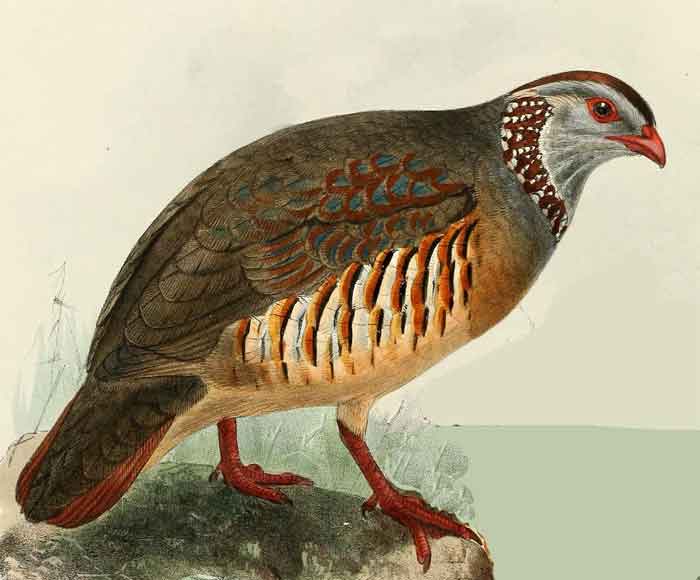
Alectoris barbara (Information about this image)
Superregnum: Eukaryota
Cladus: Unikonta
Cladus: Opisthokonta
Cladus: Holozoa
Regnum: Animalia
Subregnum: Eumetazoa
Cladus: Bilateria
Cladus: Nephrozoa
Superphylum: Deuterostomia
Phylum: Chordata
Subphylum: Vertebrata
Infraphylum: Gnathostomata
Megaclassis: Osteichthyes
Cladus: Sarcopterygii
Cladus: Rhipidistia
Cladus: Tetrapodomorpha
Cladus: Eotetrapodiformes
Cladus: Elpistostegalia
Superclassis: Tetrapoda
Cladus: Reptiliomorpha
Cladus: Amniota
Classis: Reptilia
Cladus: Eureptilia
Cladus: Romeriida
Subclassis: Diapsida
Cladus: Sauria
Infraclassis: Archosauromorpha
Cladus: Crurotarsi
Divisio: Archosauria
Cladus: Avemetatarsalia
Cladus: Ornithodira
Subtaxon: Dinosauromorpha
Cladus: Dinosauriformes
Cladus: Dracohors
Cladus: Dinosauria
Ordo: Saurischia
Cladus: Eusaurischia
Subordo: Theropoda
Cladus: Neotheropoda
Cladus: Averostra
Cladus: Tetanurae
Cladus: Avetheropoda
Cladus: Coelurosauria
Cladus: Tyrannoraptora
Cladus: Maniraptoromorpha
Cladus: Maniraptoriformes
Cladus: Maniraptora
Cladus: Pennaraptora
Cladus: Paraves
Cladus: Eumaniraptora
Cladus: Avialae
Infraclassis: Aves
Cladus: Euavialae
Cladus: Avebrevicauda
Cladus: Pygostylia
Cladus: Ornithothoraces
Cladus: Ornithuromorpha
Cladus: Carinatae
Parvclassis: Neornithes
Cohors: Neognathae
Cladus: Pangalloanserae
Cladus: Galloanseres
Ordo: Galliformes
Familia: Phasianidae
Subfamilia: Perdicinae
Genus: Alectoris
Species: Alectoris barbara
Subspecies: A. b. barbara – A. b. barbata – A. b. koenigi – A. b. spatzi
Name
Alectoris barbara (Bonnaterre, 1790) [? 1791–1792: see the note below]
Synonymy
Perdix barbara (protonym)
Note:
Bonnaterre's volume on 'ornithologie' was part of the 196-volume-strong Encyclopédie Méthodique which was issued in many "livraisons". The problem is that although the 'ornithologie' volume is dated 1790, much of the text was actually added in the 1791 and 1792 livraisons, and it is very difficult to determine when Perdix Barbara text was precisely added.
References
Tableau Encyclopédique et Méthodique des Trois Règnes de la Nature. Ornithologie. Livr.38: pl.94 fig.2, 1: 208.
Additional references
Bonnaterre, P.J. & Vieillot, L.J.P. 1791-1792, 1820. Tableau encyclopédique et méthodique des trois règnes de la nature. Ornithologie. 1: (1791) pp. 1–152; (1792) pp. 153–320; (1820) pp. 321–402. Agasse, Paris. DOI: 10.5962/bhl.title.119325 BHL Reference page.
Vernacular names
العربية: حجل بربري
български: Берберски кеклик
brezhoneg: Klujar gakelik
català: Perdiu nord-africana
čeština: Orebice berberská
Cymraeg: Petrisen Barbari
dansk: Berberhøne
Deutsch: Felsenhuhn
English: Barbary Partridge
Esperanto: Berbera perdriko
español: Perdiz moruna
euskara: Afrikar eper
فارسی: کبک بربری
suomi: Kalliopyy
français: Perdrix gambra
galego: Perdiz moura
magyar: Barnanyakú szirtifogoly
italiano: Pernice sarda
кырык мары: Бербери кеклик
Nederlands: Barbarijse patrijs
norsk: Berberhøne
polski: Góropatwa berberyjska
پنجابی: بربری چکور
русский: Берберийская каменная куропатка
sardu: Perdija
српски / srpski: Афричка камењарка
svenska: Klipphöna

The Barbary partridge (Alectoris barbara) is a gamebird in the pheasant family (Phasianidae) of the order Galliformes. It is native to North Africa.
Distribution
The Barbary partridge has its main native range in North Africa, and is also native to Gibraltar[2] and the Canary Islands (Alectoris barbara ssp. koenigi).[3] It has been introduced to continental Portugal and Madeira, though there are no recent records of this species on the latter islands. It is also present in Sardinia.
Description
The Barbary partridge is a rotund bird, with a grey-brown back, grey breast and buff belly. The face is light grey with a broad reddish-brown gorget. It has rufous-streaked white flanks and red legs. When disturbed, it prefers to run rather than fly, but if necessary it flies a short distance on rounded wings.
It is closely related to its western European equivalent, the red-legged partridge. It is similar to the red-legged partridge, but it has a different head and neck pattern. The song is a noisy tre-tre-tre-tre-tre-cheeche-tre-tre-tre.
Breeding
Eggs of Alectoris barbara - MHNT
This 33–36 cm bird is a resident breeder in dry, open and often hilly country. It nests in a scantily lined ground scrape laying 10-16 eggs. The Barbary partridge takes a wide variety of seeds and some insect food.
The Barbary partridge is the national bird of Gibraltar.[4]
References
BirdLife International (2016). "Alectoris barbara". IUCN Red List of Threatened Species. 2016: e.T22678707A85855433. doi:10.2305/IUCN.UK.2016-3.RLTS.T22678707A85855433.en. Retrieved 19 November 2021.
"The Gibraltar Bird List: Bird species observed in or from the territory of Gibraltar". Gibraltar Ornithological & Natural History Society. Archived from the original on 3 July 2007. Retrieved 2007-07-24.
(in Spanish) Martín P., Cardona A., Avifauna Canaria II, Aves de las Zonas Bajas p 55
"Gibraltar's Culture and Customs". Retrieved 3 August 2011.
Retrieved from "http://en.wikipedia.org/"
All text is available under the terms of the GNU Free Documentation License

